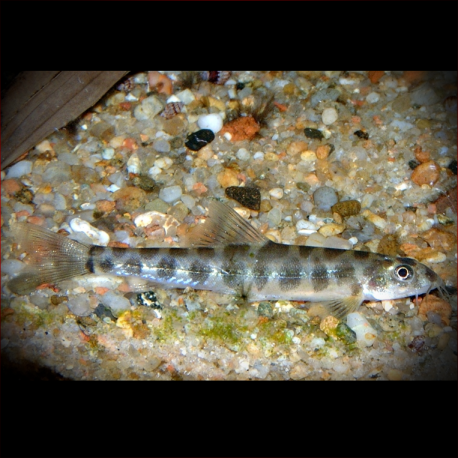More info
Datasheet
| Minimum Tank Size | 60 litres / 15.85 US gallons |
| Maximum Size | 4.5cm / 1.77inches |
| Temperature | 15°C / 59.00°F - 24°C / 75.20°F |
| Hardness | 2.02dgH / 36ppm - 15.02dgH / 268ppm |
| pH | 6.0-8.0 |
General Description
Nemacheilus corica, commonly known as the Corica loach, has extended pectoral fins, a complete lateral line, and a color pattern with variably-sized dark spots arranged along its dorsal surface and flanks. It is characterized by a row of markings along the lateral line and a dark blotch at the base of the caudal fin. The fish is a member of the Nemacheilidae family, primarily found in temperate climates with heavy rainfall and high humidity.
Aquarium Setup
Maintaining Nemacheilus corica in an aquarium resembling a flowing stream or river is ideal, with a substrate of rocks, sand, gravel, and water-worn boulders. Adding driftwood branches for cover and shade, along with hardy aquatic plants like Microsorum or Anubias spp., is recommended. The tank should have a high level of dissolved oxygen and some water movement, achieved through power filters, powerheads, or airstones. Regular water changes of 30-50% tank volume are necessary to prevent organic pollutants accumulation.
Behaviour
The Corica loach is not aggressive and can coexist in a community aquarium, especially with tankmates from similar biotopes like Danio, Devario, and Rasbora species. While not a schooling fish, it thrives best in the presence of conspecifics and minimal aggression is expected when ample cover is provided. Mixing it with similarly-shaped relatives is not advised, except in larger aquariums.
Feeding and Diet
This species is omnivorous, feeding on small insects, worms, crustaceans, and zooplankton, with a minor portion of plant matter and detritus. In the aquarium, a varied diet including live and frozen foods like Daphnia, Artemia, and bloodworms is essential for optimal coloration and condition, alongside suitable-sized dried foods.
Reproduction & Dimorphism
Information on the reproduction of Nemacheilus corica remains unreported. Adult females typically exhibit a slightly larger and heavier body compared to males, showing sexual dimorphism within the species.
Habitat and Distribution
Corica loaches are native to river systems such as the Kosi/Koshi River and its tributaries in Nepal, northern India, and Bangladesh. They inhabit slow-moving streams with clear water, sandy substrates, and organic detritus, often coexisting with various other aquatic species in these habitats. Reports from additional locations like Pakistan and certain Indian states are yet to be confirmed.

